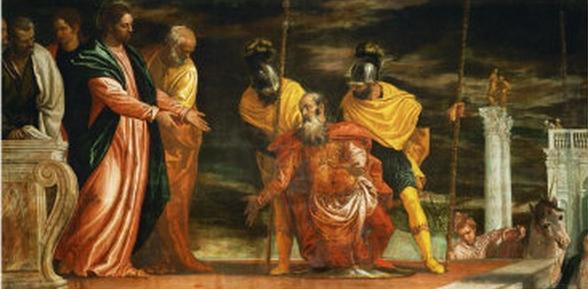 Things Fall Apart, by the Nigerian writer Chinua Achebe, published in 1958, is often labeled as the “archetypal modern African novel.” Set in the 1890s, at the beginning of British colonial rule, its protagonist is a hard-driving Igbo yam farmer, warrior, and village leader named Okonkwo, who holds himself, his wives, and his children to high standards of hard work and respect for ancestral traditions.
Things Fall Apart, by the Nigerian writer Chinua Achebe, published in 1958, is often labeled as the “archetypal modern African novel.” Set in the 1890s, at the beginning of British colonial rule, its protagonist is a hard-driving Igbo yam farmer, warrior, and village leader named Okonkwo, who holds himself, his wives, and his children to high standards of hard work and respect for ancestral traditions.
Things Fall Apart was always on my list of Classics I Should Read Some Day, and two weeks ago, facing a 1,000-mile drive, I checked out the audio book from the library. Having cleared the urban areas of Colorado Springs and Denver and entered the High Plains on Interstate 76, I slipped the first CD into the player.
Somewhere in South Dakota I finished it. And I connected it with a a book that I had been reading in September, Alan Cameron’s The Last Pagans of Rome.
Achebe is writing historical fiction about villagers confronted (in the last fourth of the book) by the British colonial apparatus and Anglican missionaries. Cameron is examining the persistent idea that there was a self-consciously Pagan resistance in the Western Roman Empire during the 4th century to imperial Christianity — this a generation or two after the last Pagan emperor, Julian (who would have called himself a “Hellene”), failed in his attempt to decouple Christianity from the power of the empire.
Achebe’s characters are fictional subsistence farmers. Cameron looks at the writing and actions of upper-class Romans 1,600 years earlier, mostly men whose birth and wealth entitled them to a seat in the Roman Senate, even though little power came with the job — the power by then was centered far away in Constantinople.
As the book’s cover blurb notes,
It is indeed widely believed that a largely pagan [sic] aristocracy remained a powerful and active force well into the fifth century, sponsoring pagan literary circles, patronage of the classics, and propaganda for the old cults in art and literature. The main focus of much modern scholarship on the end of paganism in the West has been on its supposed stubborn resistance to Christianity. The dismantling of this romantic myth is one of the main goals of Alan Cameron’s book. Actually, the book argues, Western paganism petered out much earlier and more rapidly than hitherto assumed.
Cameron argues in fine-grained detail that there was no such stubborn resistance based on a clash of theologies. To these high-class Romans, the “old religion” was largely about social position and tradition. To be named to a college of priests was a social honor, perhaps like being invited to serve on the board of directors of a symphony orchestra. (Something similar happened on a smaller scale in Okonkwo’s village.) When they were able to keep their social position (and their copies of the Iliad) while accepting Christianity, they did so.
Likewise, in Things Fall Apart, as the Christian missionaries begin to attract more and more converts, and those converts attack the traditional religion, such as by killing a sacred python in a village shrine, someone asks one of the elders why they don’t fight back.
“It is not our custom to fight for our gods,” said one of them. “Let us not presume to do so now. If a man kills the python in the secrecy of his hut, the matter lies between him and the god. We did not see it. If we put ourselves between the god and his victim we may receive blows intended for the offender. When a man blasphemes, what do we do? Do we go and stop his mouth? No. We put our fingers into our ears to stop us from hearing. That is a wise action.”
And when one group, including Okonkwo, does burn the missionaries’ church, they are punished by the colonial authorities, which breaks their resolve. The disruption of the structure of traditional authority and the disruption of traditional religion go hand in hand.
I am left with some thoughts:
• Whereas the Emperor Julian understood that Hellenic religion, literature, and philosophy were all interrelated and strove to keep that cosmos in place, the glue was looser in the Western Empire.
In their world, confronted by one British district commissioner, his African policemen, and a missionary or two, the Igbo people did not understand the scale of what was happening.
• Most people do not fight over theology anyway. Theology is often just a group marker, “us versus them.” The theological claims themselves are secondary. People fight for their group more than “for the gods,” perhaps.
• People will change religion for a variety of reasons—to get along with a spouse’s family, to gain or to retain their social status (the Roman senatorial class), or to avoid having their heads chopped off (anyone confronted with Islamic expansionism).
• An “organic” Pagan society is the dream of many, but as Things Fall Apart illustrates, such a society can be transformed within one generation.
• I do, of course, consider both the traditional Igbo and the fourth-century Romans to be Pagan, using the term as we now define it. There is no other choice when “traditional religion goes global” either, as the recent New York Times piece about a West African traditional priest working in New York City described. When geographical and cultural boundaries are crossed, we need a “global” descriptor.
• Can we construct a theology — or is it part of Pagan theology today — to say that the gods fight their own battles?
Like this:
Like Loading...





 Things Fall Apart
Things Fall Apart
